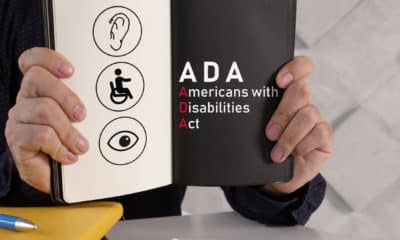Craig Berger is the chairman of the Visual Presentation and Exhibition Design Program at the Fashion Institute of Technology, as well as principal of Craig Berger Manage-ment Consulting. His firm devises marketing, education, design and management approaches for designers, fabricators, manufacturers and clients. He can be reached at craigberger19@comcast.net.
I’ve been educating sign- and environmental-graphic-design professionals about Americans with Disabilities Act (ADA) regulations for 10 years (especially during the last year on behalf of Nova Polymers). Many key issues arise repeatedly. Every month, like clockwork, my e-mail inbox fills with many basic regulatory questions. Not only are fabricators and designers asking, but some local, code-enforcement officials inquire as well.
The new ADA code requirements become mandatory nationwide March 15, so it’s timely to provide a primer on four key issues. Widespread lack of knowledge about these essential areas has hindered creativity in producing ADA-compliant signage, and nullified many improvements the code provides.
Temporary/permanent distinctions
All sections I refer to below are in 2009’s update of ADA guidelines. A novel idea in the new ADA is to specifically prescribe where ADA signs will be installed. The new ADA has a chapter devoted to required ADA sign locations. Its most vital elements follow:
“Section 216: Signs
216.1 General. Signs shall be provided in accordance with 216 and shall comply with Section 703.
EXCEPTIONS:
1. Building directories, menus, seat and row designations in assembly areas, occupant names, building addresses, and company names and logos shall not be required to comply with 216.
2. In parking facilities, signs shall not be required to comply with 216.2, 216.3, and 216.6 through 216.12.
3. Temporary [seven days or less] signs shall not be required to comply with 216.
4. In detention and correctional facilities, signs not located in public-use areas shall not be required to comply with 216.”
The exemptions for prisons, directories, occupant names and parking facilities are quite clear (though I still get questions about them). However, defining temporary signage can be tricky. Does “seven days or less” refer to the length of time a temporary facility is open, the sign’s duration, or something else? Is it open to interpretation? This gray area is often construed to mean facilities that can’t quickly be repurposed for another use should be marked with a permanent designation.
Advertisement
In other words, restrooms, cafeterias, media rooms with special equipment, or auditoriums with specific names should be marked by full names on signs, while offices and other, easily changeable spaces may retain a simple alphanumeric address system.
Character spacing
Sometimes, a small, sign-code omission enormously impacts sign designs. See if you can spot this one:
Under Section 703.2 under Raised Characters, there’s “703.2.7 Character Spacing. Character spacing shall be measured between the two closest points of adjacent raised characters within a message, excluding word spaces. Where char-acters have rectangular cross-sections, spacing between individual raised characters shall be 1/8 in. (3.2mm) minimum and four times the raised character stroke width maximum.”
What’s missing from this simple paragraph? A notation that the 1/8-in. separation is defined as between an “I” and an “O,” which are used on the basis of font kerning (adjusting the letter spacing based on character pairs). If such spacing was followed strictly, letters like “A” and “W”, whose line strokes move in opposite directions, would be much farther apart than an “I” and an “O,” and make words both less aesthetically pleasing and less readable. Unfortunately, though, this is the ADA’s intent for all uppercase, tactile letters. For characters that use upper and lower case, the common practice involves letter tracking based on separation between an “I” and “O”, and a percentage of the character height. That’s found in a different ADA section – under 703.5, “Visual Characters:”
"703.5.8 Character Spacing. Character spacing shall be measured between the two closest points of adjacent characters, excluding word spaces. Spacing between individual characters shall be 10% minimum and 35% maximum of character height.”
Dual braille/tactile signs
The American National Standards Institute spent 10 years refining the national codes to allow for dual signs. Previously, all identification signs had to conform to the needs of both the blind and visually impaired using the same typography, which didn’t satisfy either group’s needs.
Advertisement
Dual-function signs contain both information for the blind – utilizing smaller tactile, sans-serif letters with low contrast, and large, high-contrast, sans-serif letters designed to aid the visually impaired. Unfortunately, this misleading section of the code begins with a simple, yet confounding, section:
“703.1 General. Signs shall comply with [Section] 703. Where both visual and tactile characters are required, either one sign with both visual and tactile characters, or two, separate signs, one with visual and one with tactile characters, shall be provided.”
This section baffles many code officials, and is often avoided by designers and fabricators who don’t want to explain this option to customers. They revert to providing tactile and visual components with identical letterforms, which is code-compliant, but not an ideal solution.
This is a pity. Numerous, modular systems employ the dual-sign approach (the system Roger Whitehouse developed for ASI provides a prime example), and these signs allow for both greater creativity and better serving both the blind (a small group) and the visually impaired (which, at various times, will include the majority of the population) communities.
Proper use of domed braille
An entire materials industry has evolved with tactile signs, but questions about domed braille are still raised quite often. The updated ADA rules are quite clear (at least by ADA-guidelines standards) in this area:
“Section 703.3.1 Dimensions and Capitalization. Braille dots shall have a domed or rounded shape and shall comply with Table 703.3.1.”
Advertisement
This means the dots need to be either completely domed or have a rounded-shape top. Doming is
most commonly achieved through the Raster Braille method, which secures raster spheres held in place by friction, and rounded-top dots are fabricated by bonding the top layer to photopolymer or chemically etched metals following manufacturer specifications.
The debate on proper domed-braille fabrication ended years ago, so these manufacturing approaches are universally accepted for ADA signs. I am sure these questions will continue to inundate my inbox for years to come, but at least I can readily answer them within this article.



 Tip Sheet1 week ago
Tip Sheet1 week ago
 Ask Signs of the Times3 days ago
Ask Signs of the Times3 days ago
 Real Deal1 week ago
Real Deal1 week ago
 Photo Gallery22 hours ago
Photo Gallery22 hours ago
 Benchmarks5 days ago
Benchmarks5 days ago
 Editor's Note2 weeks ago
Editor's Note2 weeks ago
 Women in Signs1 week ago
Women in Signs1 week ago
 Photo Gallery1 week ago
Photo Gallery1 week ago









